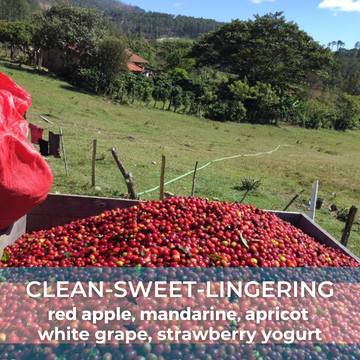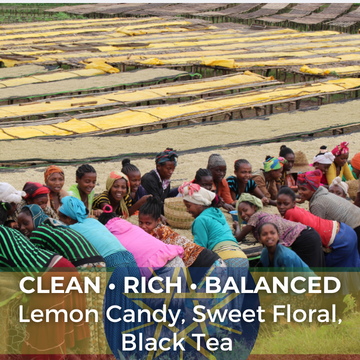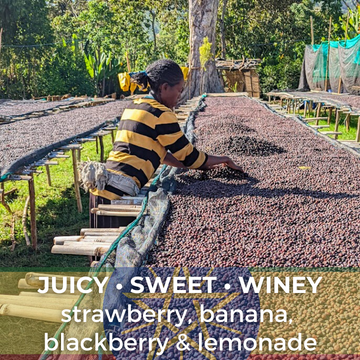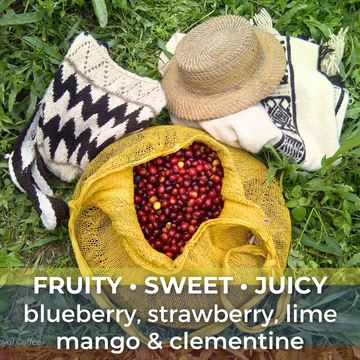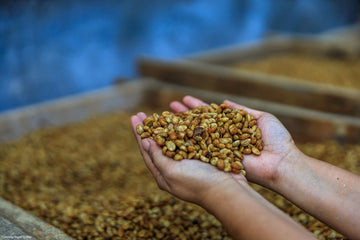Sold Out
Ethiopia Keffa Wush Wush Red Honey
We just can't get enough Wush Wush! This Red Honey processed lot shows what happens when you combine the fruitiness of natural with the bright florals of washed. It's balanced and clean with notes of pink apple, golden raisin, honeycomb, iris and lemon peel.
Unless you watch the coffee world as closely as we do, you’ve probably never heard of the little Ethiopian village of Wush Wush. If you have heard those two magical words, you might be thinking “Wait, isn’t Wush Wush a coffee variety, like Gesha?” Oh, it is and it’s named after the village where is was first identified, also known as Wushwush. Located in that little village is a washing station owned and operated by Dinkalem Ademe and his wife Sofiya who source their coffee from about 2500 smallholder farms in the surrounding area. All that coffee consists of naturally adapted heirloom varieties descended from the originally identified Wush Wush variety. That’s all a roundabout way of saying: this coffee is the real deal!
But wait, there’s more! The Ademes and their partners at Catalyst Trade have gone one step farther, applying Catalyst’s Red Honey process to this particular lot. Named for the sweet, sticky substance (known technically as “mucilage”) left behind on the beans during the early stages of processing, this process mixes the best of both worlds. You get some of the sweet, fruitiness of natural processing along with the crisp acidity and balance often found in fully washed processing. At risk of oversimplifying this complicated process, the color of the Honey refers to how much of the mucilage was left behind prior to drying. For instance, Black Honey means that as much mucilage as possible was left behind to dry on the beans. As the beans finish drying, the mucilage becomes increasingly darker and richer, turning the beans a characteristic splotchy black prior to milling. This is in comparison to Red and Yellow honey, which leave behind less and less mucilage respectively. You can expect that as the color changes from Yellow, to Red and finally to Black, the cup profile goes from resembling a washed coffee to being closer to the natural processed end of the spectrum.
As you might expect, Red Honey lands right in the middle of the Black/Red/Yellow spectrum and also lands right in the middle of the natural to washed spectrum. What we got was a very clean cup with zesty acidity and great balance along with good body and a pleasant creamy texture. The flavors are fruity and sweet but much less intense than it’s Black Honey and Natural counterparts and more floral notes shine through. In the cup we noted pink lady apple, golden raisin, lemon zest and gentle iris.
Reminder! This coffee is raw, you must roast it before brewing
Arrival Date: December 23rd, 2022. Harvest year: 2022, packed in GrainPro
Acidity & Brightness: Bright and fairly sweet
Balance & Finish: Balanced with a crisp, clean finish
Body & Texture: Medium to full bodied and creamy
Flavors: Dried lemon peel, honeycomb, pink lady apple, golden raisin & iris
Grade: Grade 1, grown at 1,850 to 1,950 masl
Processing: Natural (dry) processed, fermented for a short period of time, dried under shaded canopy on drying beds for 4 to 5 days
Grower: 2500 smallholder farmers| Dinkalem Ademe’s washing station
Region: Wush Wush village, Ginbo District, Keffa Zone, Ethiopia
Varietals: 75/210 and 74/212, smaller quantities of 74/110 and 74/165 and local Landrace varieties, naturally adapted from the Wush Wush variety
Recommended Roast Range: City to Full City (Light to medium)
Start at City (light) or just about 30 seconds into rolling first crack. From there, go a bit darker if desired, but find it best not to go any darker than Full City (Medium or after the end of first crack and before 2nd crack starts). Most folks will prefer a City + or at the tail end of first crack. Lighter roasts will have more tangy acidity while medium roasts will accentuate more body and rounded sweetness. Longer rest times are recommended (72+ hours) for optimal brewing performance.
Catalyst Trade - "Approximately 2500 smallholder farmers from the surrounding area bring their cherries to Dinkalem Ademe’s washing station, where the sign above the gate says, “GENALEM GEWYERO” —GOD IS GOOD”—a motto he and his wife, Sofiya have taken for their lives. Together they are a dynamic couple dedicated to helping their communities in every way. The outgrowers in the Ginbo district are smallholders, aka “garden farmers,” so called because most of them are producing coffee in the “garden” areas around their homes, and often harvesting cherries from coffee occurring naturally on the land where they live.
RED HONEY PROCESS For the higher density cherries, another hand sorting follows the floating process to give good uniformity for pulping. For our Red Honey processed coffees, we calibrate the disc pulper to allow for greater control and speed of pulping, which we take very slowly. The primary goal here is to minimize parchment and seed damage while really maximizing the mucilage content intact before drying.
Following pulping, we ferment the parchment slated for Red Honey for a short period of time. Then the mucilage- heavy beans are moved to shaded drying beds, where we keep them slowly drying under a shade canopy with excellent airflow. The drying with shade adds 4 to 5 days overall drying time with this Red Honey, and affords us a stable distribution of moisture content throughout the cellular structure, along with a dialed-in water activity (shade drying gives just a little more control than full sun-drying, though it can be a little tricky to cover the parchment at the right times). We find this strong uniformity in the drying of all the coffees is critical in a good honey process.
> Black, Red and White honey are so called due to the color of the parchment. Black honey coffees carry characteristic black splotches from the heavy mucilage load. Red honeys are also splotched, but less so, with the splotches more red than black. White honey carries the least mucilage and is more yellow/white in hue over all.”
